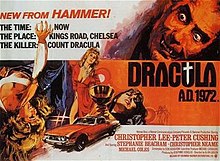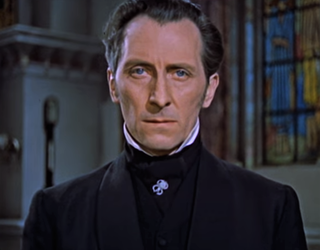
Peter Wilton Cushing was an English actor. His acting career spanned over six decades and included appearances in more than 100 films, as well as many television, stage and radio roles. He achieved recognition for his leading performances in the Hammer Productions horror films from the 1950s to 1970s, and as Grand Moff Tarkin in Star Wars (1977).
Hammer Film Productions Ltd. is a British film production company based in London. Founded in 1934, the company is best known for a series of Gothic horror and fantasy films made from the mid-1950s until the 1970s. Many of these involve classic horror characters such as Baron Victor Frankenstein, Count Dracula, and the Mummy, which Hammer reintroduced to audiences by filming them in vivid colour for the first time. Hammer also produced science fiction, thrillers, film noir and comedies, as well as, in later years, television series.

The Anno Dracula series by Kim Newman—named after Anno Dracula, the series' first novel—is a work of fantasy depicting an alternate history in which the heroes of Bram Stoker's novel Dracula fail to stop Count Dracula's conquest of Britain, resulting in a world where vampires are common and increasingly dominant in society. While Dracula is a central figure in the events of the series, he is a minor character in the books and usually appears in only a few climactic pages of each book. While many of the characters from Newman's Diogenes Club stories appear in the Anno Dracula novels, they are not the same as the ones in those stories, nor is the Diogenes Club itself the same.
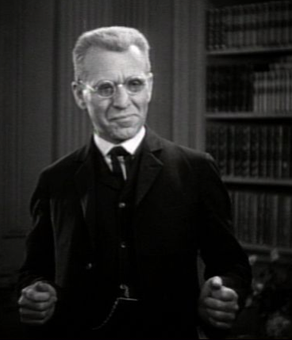
Professor Abraham Van Helsing is a fictional character from the 1897 gothic horror novel Dracula written by Bram Stoker. Van Helsing is a Dutch polymath doctor with a wide range of interests and accomplishments, partly attested by the string of letters that follows his name: "MD, D.Ph., D.Litt., etc.", indicating a wealth of experience, education and expertise. He is a doctor, professor, lawyer, philosopher, scientist, and metaphysician. The character is best known through many adaptations of the story as a vampire slayer, monster hunter and the arch-nemesis of Count Dracula, and the prototypical and the archetypical parapsychologist in subsequent works of paranormal fiction. Some later works tell new stories about Van Helsing, while others, such as Dracula (2020) and I Woke Up a Vampire (2023) have characters that are his descendants.
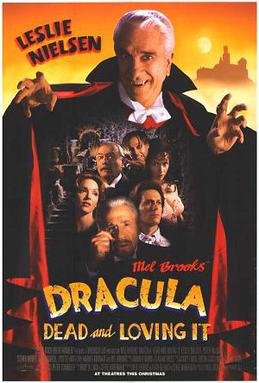
Dracula: Dead and Loving It is a 1995 comedy horror film directed by Mel Brooks and starring Leslie Nielsen. It is a spoof of Bram Stoker's novel Dracula and of some of the story's well-known adaptations.

Dracula is a 1958 British gothic horror film directed by Terence Fisher and written by Jimmy Sangster based on Bram Stoker's 1897 novel of the same name. The first in the series of Hammer Horror films starring Christopher Lee as Count Dracula, the film also features Peter Cushing as Doctor Van Helsing, along with Michael Gough, Melissa Stribling, Carol Marsh, and John Van Eyssen. In the United States, the film was retitled Horror of Dracula to avoid confusion with the U.S. original by Universal Pictures, 1931's Dracula.

Dracula 2000 is a 2000 American gothic horror film co-written and directed by Patrick Lussier and produced by Joel Soisson. Starring Gerard Butler in the title role along with Christopher Plummer, Jonny Lee Miller, Justine Waddell, Omar Epps, Colleen Fitzpatrick, Jeri Ryan and Jennifer Esposito, the plot follows Dracula, who arrives in New Orleans, Louisiana in the 21st century and seeks out Mary Heller, the daughter of Abraham Van Helsing.

Wilhelmina "Mina" Harker is a fictional character and the main female character in Bram Stoker's 1897 Gothic horror novel Dracula.

Dracula Has Risen from the Grave is a 1968 British supernatural horror film directed by Freddie Francis and produced by Hammer Film Productions. It is the fourth entry in Hammer's Dracula series, and the third to feature Christopher Lee as Count Dracula, the titular vampire. The film stars Rupert Davies as a clergyman who exorcises Dracula's castle, and in doing so, unwittingly resurrects the Count back from the dead.
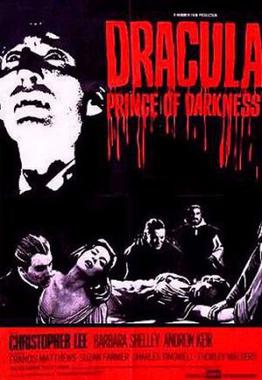
Dracula: Prince of Darkness is a 1966 British gothic supernatural horror film directed by Terence Fisher. The film was produced by Hammer Film Productions, and is the third entry in Hammer's Dracula series, as well as the second to feature Christopher Lee as Count Dracula, the titular vampire. It also stars Andrew Keir, Francis Matthews, and Barbara Shelley.

The Brides of Dracula is a 1960 British supernatural horror film produced by Hammer Film Productions. Directed by Terence Fisher, the film stars Peter Cushing, David Peel, Freda Jackson, Yvonne Monlaur, Andrée Melly, and Martita Hunt. The film is a sequel to the 1958 film Dracula, though the character of Count Dracula does not appear in the film, and is instead mentioned only twice. Christopher Lee would reprise his role as Dracula in the next film in the Dracula series, Dracula: Prince of Darkness (1966).

Scars of Dracula is a 1970 British horror film directed by Roy Ward Baker for Hammer Films. It stars Christopher Lee as Count Dracula, along with Dennis Waterman, Jenny Hanley, Patrick Troughton, and Michael Gwynn.

The Legend of the 7 Golden Vampires is a 1974 martial arts horror film directed by Roy Ward Baker. The film opens in 1804, when seven vampires clad in gold masks are resurrected by Count Dracula. A century later, Professor Van Helsing, known in the world for his exploits with Dracula, is recruited by a man and his seven siblings after giving a lecture at a Chinese university to take on the vampires. The film is a British-Hong Kong co-production between Hammer Film Productions and Shaw Brothers Studio.

The Satanic Rites of Dracula is a 1973 British horror film directed by Alan Gibson and produced by Hammer Film Productions. It is the eighth film in Hammer's Dracula series, and the seventh and final one to feature Christopher Lee as Dracula. The film was also the third to unite Peter Cushing as Van Helsing with Lee, following Dracula (1958) and Dracula A.D. 1972 (1972).
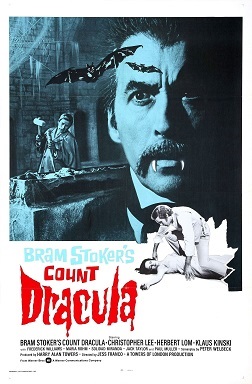
Count Dracula is a 1970 gothic horror film directed by Jesús Franco, based on the novel Dracula by Bram Stoker. It stars Christopher Lee, Herbert Lom and Klaus Kinski.

Taste the Blood of Dracula is a 1970 British supernatural horror film produced by Hammer Film Productions. Directed by Peter Sasdy from a script by Anthony Hinds, it is the fifth installment in Hammer's Dracula series, and the fourth to star Christopher Lee as Count Dracula, the titular vampire. The film also features Geoffrey Keen and Gwen Watford.
Christopher Neame is an English actor who resides in the United States.
Dracula is a British horror film series produced by Hammer Film Productions. The films are centered on Count Dracula, bringing with him a plague of vampirism, and the ensuing efforts of the heroic Van Helsing family to stop him. The original series of films consisted of nine installments, which starred iconic horror actors Christopher Lee and Peter Cushing as Count Dracula and Doctor Van Helsing, respectively. The series is part of the larger Hammer horror oeuvre.
The World of Hammer is a British television documentary series created and written by Robert Sidaway and Ashley Sidaway, and produced by Robert Sidaway.
